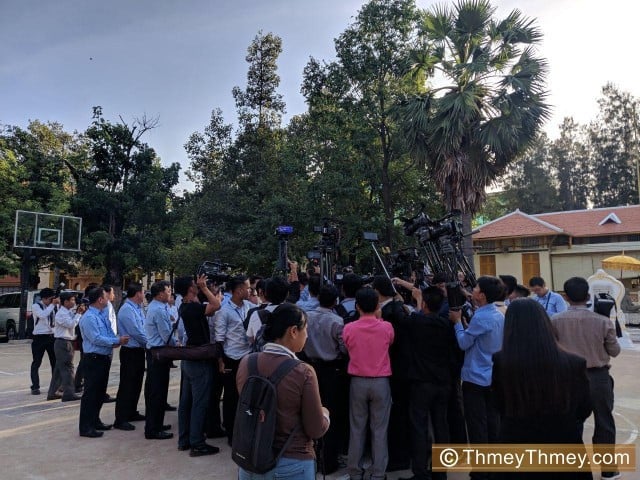Going Green No Longer Optional: Cambodia Needs a Change in Architecture and Construction

- Sao Phal Niseiy
- November 1, 2020 8:49 AM
As Founding Director at Aerne Architects & Associates and a Professor of Architecture & Urbanism at Cambodia’s Royal University of Fine Arts since 2013, Martin Aerne has brought his extensive expertise to bear in Cambodia. He shared his thoughts with Cambodianess on how the pandemic has affected building design and why developing nations must embrace green solutions to urbanization to future-proof their cities.
Sao Phal Niseiy: As a long-serving architect, in what ways do you think the COVID-19 pandemic has affected concepts of building designs in general and in Cambodia in particular?
Martin Aerne: As physical distancing and meticulous hygiene worldwide suddenly became an imperative for the time being, the concept of decentralized working became a main topic. So called hot desks, shared with multiple users, have temporarily lost their relevance. Climatized spaces nurteing an environment the virus survives in much longer and spreads and transmits more easily became a serious concern.
Since the pandemic seems not to have spread in Cambodia, besides increased distance from person to person in a coffee shop, at workplaces or in supermarkets and the use of face masks, hand sanitizers and additional hand wash opportunities offered, I see little change in the design, though automatic doors and touchless control panels would be a logical response.
Sao Phal Niseiy: Taking into account people’s needs and wellness during this health emergency, some advanced economies already begin to discuss health-oriented approaches in future design. Do you think it is time for Cambodia to push for that too?
Martin Aerne: If not for this pandemic, then well for future health hazards to come, Cambodia would do itself a favor to look over the boarders and implement relevant measures before the storm. However, given the climate that allows for much more outdoor activity in an appropriate (designed) environment than the climate of many of the technologically more sophisticated nations, Cambodia has a huge potential to move towards low cost solutions that are highly beneficial for the environment, the economy as much as the physical and mental wellbeing of its population and visitors. Such an alternative approach would likely also give the country a cutting edge for its international positioning and tourism.
Sao Phal Niseiy: Cambodia, just like other countries across the globe, is going to see increasing effects of the climate crisis and, to some extent, pandemic, hence some say it is important for the country to focus on green building design. But how green are green buildings and how do you view the current state of the green building movement in Cambodia?
Martin Aerne: To go “green” is no longer an option considering scientific facts in the light of the rapid growth of urbanization and with it the consumption of goods and energy here and worldwide, in Asia particularly. Though buildings are just a part of the puzzle, they are significant contributors to climate change besides the industry, transportation and farming. In simple terms we need to focus on the energy that goes into the construction, the energy used during the building’s life time and the emissions caused by its disposal.
The green movement here is still in its infancy and often largely a talk, a concept or just a label. Truly “green buildings” are outweighed by far by the buildings that are extremely hostile to the environment and by no means sustainable. One reason for the current dire situation is short-term thinking, as a so called “green building” might ask for a higher investment at its inception but would save the owner or user (and the world as a whole) significant funds over the medium and long term.
In a nutshell, sun shading, greenery, thermal insulation where permanent air-conditioning is unavoidable, use of material with low embodied energy unlike steel and concrete, photovoltaic power generation and natural ventilation are the key. The ordinary historical Khmer house was in fact a “super green building”—conducive for its inhabitants and the environment. Many Cambodian buildings of the 1960s too, despite being made of concrete and bricks, are still rather “green” compared to our current structures, nakedly exposed to the sun with a huge appetite for electricity for an agreeable indoor climate, yet leaving the city overheated.
Sao Phal Niseiy: What are some pressing challenges you see in implementing such projects in Cambodia?
Martin Aerne: Firstly, education, but not only of architecture students but also the population via smart campaigns. Secondly, regulations, though perhaps more effective would be incentives for those who truly invest and build environmentally friendly buildings.
Sao Phal Niseiy: As Cambodia is witnessing and continuing to see a boom in condos, apartments as well as other residential buildings, what does it take to achieve this green solution? Do you think green concept is really enough for our future?
Martin Aerne: As every nation, Cambodia needs to consider and discuss, what it really believes in. Only once being aware of its values and where it wants to go, effective strategies can be forged to steer the further development. Cambodia still enjoys the favor of many nations and can receive knowhow for noble causes if willing to invest itself all the way to the end. As long as short term profits are more important than long term goals, we will reach inevitably a point of no return and regrets.
Sao Phal Niseiy: The transition from traditional to modern architecture needs to be steady, planned and effective. What role can the government and individuals play in progress towards more a sustainable and greener society?
Martin Aerne: The government, based on reports from an independent, impartial and qualified body that evaluates and certifies new buildings, could transfer funds from conventional new constructions that would need to be significantly taxed, to green buildings as an incentive.
Furthermore, allowing anyone to feed easily into the electric grid against a substantial compensation from EDC [Electricite du Cambodge] would accelerate the increase of photovoltaic electricity generation rapidly and replace unsustainable fossil fuel.
On an individual level, tenants and new house owners should learn to pick a property based on its energy efficiency and quality of life it supports, both on a micro as well as macro level.















